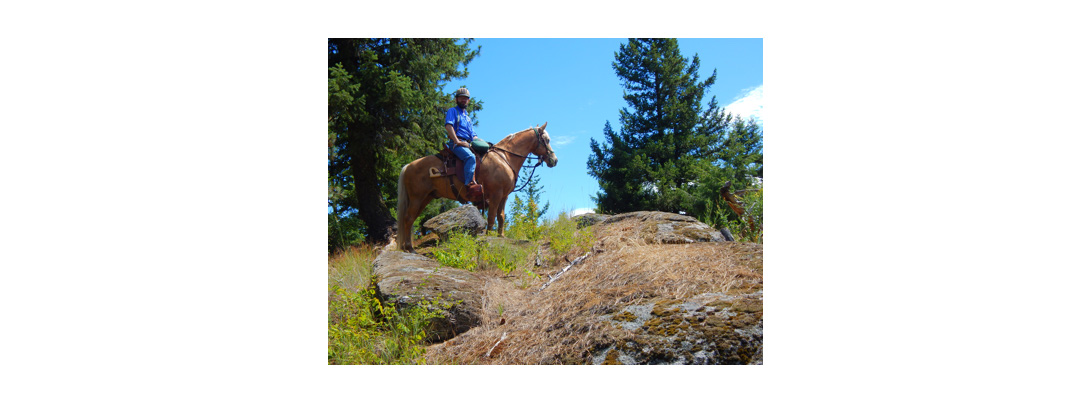Five Skills to Master Before Heading Out on the Trail
by Robert Eversole

Trail riding can be a wonderful experience. It can also be horrible and we’ve all been there. In riding back country and front country areas across the US I’ve noted what differentiates the successful from the not so successful riders. Consistently, the riders having the best time are those who have prepared themselves and their mounts prior to arriving at the trailhead.
I love Merriam-Webster’s definition of training: “The process by which an athlete prepares for competition by exercising, practicing, etc.” Riders, and their mounts, are athletes and trail riding is not an endeavor where we can expect success without preparation. From what I’ve seen, the quickest way to shake a rider’s confidence is the inability to confidently ask the horse to perform a task without confusion or resistance. Effective communication requires proper use of cues. To help in the learning process a good riding instructor with trail riding experience, as opposed to show training, is invaluable. I chatted with Erin Richardson of Keystone Equestrian in Fall City, WA (www.keystone-equestrian.com) about the trail training issues she regularly deals with and why mastery of these skills is important for riders.
Before arriving at the trailhead the horse should be comfortable with standing quietly, moving forward freely and moving off the rider’s leg. The rider should be able to use all of the basic riding aids and the horse should be willing and able to respond appropriately. Once you’ve mastered these basics you’ll be ready for the advanced schooling that will become invaluable for trail riding. A few of the secondary skills that you and your horse should possess include:
Neck Reining. The ability to steer with one hand is one of the most useful skills for trail riding. Having a free hand allows the rider to move low hanging branches out of the way, grab a snack, or lead a pack string. Erin says: “I see neck reining as the ability to ride primarily with seat and leg cues. If your horse is light and willing to be guided off subtle aids it’s very easy to free up a hand for other jobs.”
Backing. It only takes one trip down a narrow trail to appreciate a horse that will back willingly and allow itself to be steered back to safety. The ability to back my horse out of a tight situation has been the escape path for my curiosity more than once. Erin says: “Practice backing on varied terrain and through obstacles to practice responsiveness and trust. Your horse should also be able to stop and wait quietly.”
Leg Yields and Side-passing. If you value your knees, you’ll quickly appreciate the ability to ask your mount to move away from that large, very hard, tree. Side-passing is only different in that the horse is standing still when you ask him to step to the side—perhaps for a hiker with a small child in tow. Erin says: “Most riders can move their horse sideways, but few can do it precisely. Think moving only one step, or a specific foot, sideways.”
Mounting from Both Sides. This is a very valuable skill to learn and practice. I’m not nearly tall enough to mount from the downhill side of the trail and in many areas turning around to mount from the “correct” side isn’t feasible. Erin says: “Your horse should be able to stand quietly while you mount and get settled in the saddle, then wait for your cue to go.”
De-spooking. Exposing your mount to many of the sights he’ll meet on the trail is important. I’d much rather have my horses encounter bicycles for the first time at home than on the trail. While you’ll never completely eliminate a spook, you’ll be surprised at how much you can reduce it by constantly exposing your animals to new stimuli. I often ride my bike in the paddock with a backpack on. It looks silly, but my horse LT now takes most trail encounters in stride. Erin says: “Be aware of potentially scary encounters and teach your horse to be curious and to trust where you place his feet.”
We live in an amazing region of the country and exploring it on horseback can be phenomenal. A little bit of preparation will ensure that it is. As always, for more information on where to ride in the Pacific Northwest, and beyond, as well as the largest directory of equine events please visit www.TrailMeister.com.
Originally Published September 2014 Issue

Robert Eversole, ”the trail meister,” owns www.TrailMeister.com, the largest database of horse riding and camping areas in the U.S. with free trail and trailhead information, trail maps, and much more to help horse enthusiasts experience the joys of trail riding. Robert is a registered riding instructor with PATH International, a mounted search and rescue team member, and a U.S. Marine who has served on the board of the Backcountry Horsemen of Washington (BCHW). He is enjoying his new career helping fellow trail riders stay found and safe on the trail. When not on the trail, The Trail Meister resides near Spokane, WA and teaches land navigation to a wide variety of outdoor groups across the nation. For North America’s largest horse trail and camping directory, trail tips, and more, visit www.TrailMeister.com.






